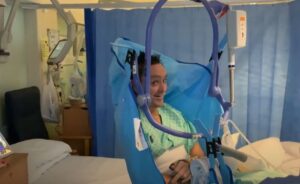David had been eagerly waiting for the day when he could try out an electric wheelchair, but for him, it wasn’t just about gaining some control and independence over his mobility. As someone with a spinal cord injury that had left him with limited movement in his arms, the prospect of using an electric wheelchair was both exciting and daunting.
When David arrived at the occupational area, he was accompanied by his therapist and friend Chris, who was tasked with keeping a finger on the stop button in case David got into trouble. Despite feeling nervous, David was determined to make the most of this opportunity.
After some adjustments to the chair and a brief tutorial on the controls, David set off on his first lap around the hospital corridors. But for David, the challenge of controlling the chair was far more difficult than it was for most people. His movement primarily came from his shoulders, and his limited arm movement meant that he had to use this day to test what he is capable of.
With the guidance of his therapist and encouragement from Chris, David slowly started to get the hang of it. As he whizzed down the hallways and around corners, he felt a sense of exhilaration. For the first time in months, he was able to move around independently, without relying on others to push him. It was a feeling of freedom that he had almost forgotten existed.
But the challenges were far from over. As David continued to practice using the chair, he was faced with the physical effort and concentration required to control it. His arms and shoulders were quickly taxed, and by the end of the session, he was feeling exhausted. The freedom that the electric wheelchair offered him came at a significant cost.
For David, the struggle of his spinal cord injury is a daily battle. He faces limitations in his mobility that most people take for granted, and even the simplest tasks can be a significant challenge. The electric wheelchair has given him a newfound independence, but it’s important to recognize that this comes at a cost – a physical and emotional cost that is often overlooked.
As he returned to his ward, David felt a sense of hope for the future. With his electric wheelchair, he knew he could do more and go further than ever before. But he also knew that it would take determination and perseverance to overcome the challenges that lay ahead. And it’s essential that we recognize and support those who, like David, face these challenges every day.





